Stamping out COVID-19 is within Australia's sights as the growth of new cases slows to a trickle, but a leading infectious disease expert says it will take at least a year of living with restrictions before the coronavirus could be declared eliminated, reports Dana McCauley.
Professor Raina MacIntyre from the University of NSW Kirby Institute said that although the number of confirmed cases in Australia was now low, the key to eliminating COVID-19 was in stamping out community transmission, where the virus spreads without a known source.
"Elimination means not having sustained domestic transmission," Professor MacIntyre said.
"Australia can achieve this, but it would require a demonstration of a sustained period of low disease incidence - probably a year or more."
In that time, she said, authorities would need to maintain high levels of testing and contact tracing, keep international borders closed, continue with social distancing and potentially introduce "universal face mask use".
You can read Dana's full report here.
Since March, Australia's ambassador in the Philippines Steve Robinson and his team have facilitated the return of 2309 Australian citizens and permanent residents on eight international flights.
Onboard one of those flights was three-year-old Lukas McNeill. He had been taken to the Philippines by his father, Ian, to attend a wedding in February and was to be brought back by his grandfather in early April.
Because of the country's unique geography with 2000 inhabited islands, Mr Robinson's team arranged 29 "sweeper flights" across the three missions to retrieve people from far-flung locations. It took some people 18 hours just to reach a regional airport to board one of these sweeper flights.
The first flights departed Manila on April 18 with Mr Robinson's 200 embassy staff working past midnight to get the planes in the air. Ten days later, they did it all again before a third mission on Tuesday this week.
Globally, the Department of Foreign Affairs and Trade (DFAT) has provided direct assistance to help about 22,000 people reach Australian shores, including 6500 cruise passengers. It estimates more than 300,000 have returned home in total since Prime Minister Scott Morrison sounded the alarm.
You can read Josh Dye's full story here.
Labor’s treasury spokesman Jim Chalmers says the Morrison government needs to release a major new housing package to save residential construction in Australia.
Sky News reported on Sunday morning the federal government will unveil a new homeowner grant in a bid to avoid a drop of up to 50 per cent in residential construction because of the coronavirus pandemic. According to the report, the grant won’t just be given to first home buyers and will be available across the board.
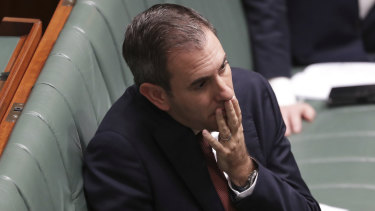
Shadow Treasurer Jim Chalmers. Credit:Alex Ellinghausen
Mr Chalmers said Labor supported grants but there also needed to be support for tradies, social housing, a program to try to house essential workers closer to their work and a lifting of the cap on the loan deposit scheme.
“Let’s see what they announce during the week… but [Labor leader] Anthony Albanese and [Opposition housing spokesman] Jason Clare have been saying for more than a month now that residential construction has the capacity to play a really important role in this recovery,” Mr Chalmers told Sky News.
“Already before the crisis construction was relatively weak and homeownership was at 60-year lows, so we had a challenge there, that challenge has been exacerbated obviously by this coronavirus crisis. In two or three months we are very worried construction will fall off a cliff.”
The high country town of Bright in Victoria is getting ready for people to return from Monday, after five months of quiet, which began with the Black Summer bushfires in January.
Accommodation providers say the phones never ran so hot as they did last week in the hours after Premier Daniel Andrews announced that Victorians could soon venture to the regions for overnight stays.
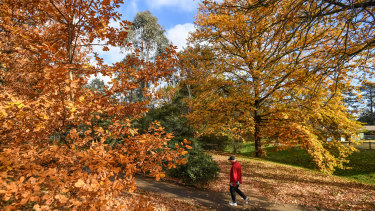
Bright is cautiously optimistic about Monday's reopening to overnight tourists.Credit:Joe Armao
Locals are generally grateful and optimistic, if not desperate, but some also fear tourists will bring more than dollars to a town so far untouched by COVID-19 cases.
People are uncertain how restaurants and pubs will manage the 20-person limits and strict hygiene requirements. Or how in the weeks and months ahead, managers will find the workers to serve, cook and wash dishes - jobs normally done by visitors on working holiday visas.
With the ski season beginning on June 22, people ask if the nearby resorts can manage social-distancing in a way that will ensure families and groups still want to come in sustainable numbers
You can read Zach Hope's full story here.
Health experts in the US are worried the massive protests sweeping across US cities since the death of black man George Floyd could lead to a new surge in COVID-19 cases.
Some leaders appealed for calm in places where crowds smashed storefronts and destroyed police cars in recent nights have handed out masks and warned demonstrators they were putting themselves at risk.
Minnesota's governor Tim Walz said on Saturday that too many protesters weren't socially distancing or wearing masks after heeding the call earlier in the week. But many seemed undeterred.
"It's not OK that in the middle of a pandemic we have to be out here risking our lives," Spence Ingram said Friday after marching with other protesters to the state Capitol in Atlanta. "But I have to protest for my life and fight for my life all the time."
Ingram, 25, who was wearing a mask, said she has asthma and was worried about contracting the virus. But she said as a black woman, she always felt that her life was under threat from police and she needed to protest that.
The demonstrations over the killing of George Floyd, a black man who died after a Minneapolis officer pressed a knee into his neck, are coming at a time when many cities were beginning to relax stay-at-home orders.
"Whether they're fired up or not that doesn't prevent them from getting the virus," said Bradley Pollock, chairman of the Department of Public Health Sciences at the University of California, Davis.
Even for the many protesters who have been wearing masks, those don't guarantee protection from the coronavirus. The Centers for Disease Control and Prevention recommends cloth masks because they can make it more difficult for infected people to spread the virus - but they are not designed to protect the person wearing the mask from getting it.
The US has been worst hit by the coronavirus outbreak, with more than 1.7 million cases and over 103,000 deaths, according to a tally kept by Johns Hopkins University.
AAP
The coronavirus pandemic has taken a huge toll on sleep, with nearly half of respondents to a global study by Australian experts reporting poor sleep and two in five waking frequently in the night.
The study, which had more than 2000 people responses, will show 46 per cent are sleeping poorly during the pandemic, compared with 25 per cent before it, and 41 per cent are waking during the night three or more times a week, a symptom of insomnia.
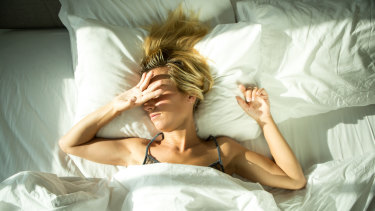
The coronavirus pandemic has taken a huge toll on sleep.Credit:iStock
Melinda Jackson of the Turner Institute for Brain and Mental Health at Monash University said the causes of sleep disruption included pandemic stress, anxiety, job changes and financial distress.
Heavier alcohol consumption was a factor for 39 per cent of those whose sleep was worse, and increased phone usage was also a cause, she said. Some people could develop insomnia that lasted beyond the pandemic.
But the Monash study, which will be published later this year, will also show 42 per cent of those whose sleep was bad before the pandemic had found it improved because they could sleep and work in a routine that suited their body better.
The Andrews government is asking large employers to stagger start times for workers and will consider adding extra public transport services as part of a strategy to avoid overcrowding on trams, trains and buses, reports Zach Hope.
Conversations have already begun between government agencies and major CBD employers that may lead to increased shiftwork and workers being asked to continue working from home on certain days.
While part of a broader push to keep Victorians safe from the coronavirus threat, the willingness of workplaces to change business-as-normal processes will form a crucial plank of the post-restrictions public transport strategy.
Jeroen Weimar, the departmental lead on the state's coronavirus transport strategy, said the insides of trams or trains would not undergo any structural changes as part of the plan.
He ruled out mandatory masks on public transport or using commuter data, such as Myki, for the purposes of contact tracing.
And he said that while teams would regularly clean surfaces and help commuters, there would no enforcement of social distancing.
Queenslanders and the rest of the country alike will be keen to hear the outcome of today's decision from the state government on its controversial border closures, as well as its anticipated announcement of easing restrictions on bars and restaurants.
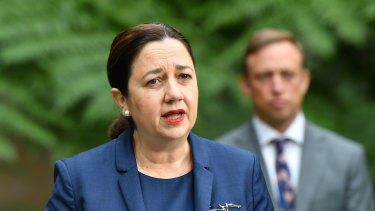
Queensland Premier Annastacia Palaszczuk will be making key decisions on whether borders, bars and restaurants will open today. Credit:AAP
Premier Annastacia Palaszczuk has been firm on her view that the Queensland border should remain closed until Victoria and New South Wales go 28 days without recording a new coronavirus case, but the benchmark may be rolled back following the monthly review today.
Bars and restaurants may also see restrictions eased. Queensland currently allows venues to seat a maximum of 10 patrons, but that may change today following meetings with peak bodies on Thursday.
Read more on this from Lydia Lynch.
Romanian Prime Minister Ludovic Orban has paid a 3000 lei fine ($A1035) for breaking his own coronavirus restrictions by not wearing a face mask and smoking indoors, state news agency Agerpres says.
A picture which went viral on social media shows Orban in his office, sitting around a table with several other cabinet members, smoking a cigarette while none of them wore masks.
Their masks were thrown on the table.
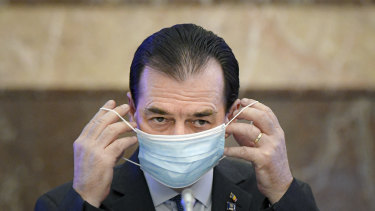
Romanian Prime Minister Ludovic Orban has been fined for breaching his own COVID-19 rules. Credit:AP Photo/Andreea Alexandru
In a statement, Orban acknowledged breaching the rules, saying some cabinet members gathered at his office after a long working day on May 25, his 57th birthday.
"The prime minister knows rules must be obeyed by all citizens, regardless of their position. If the law is broken then sanctions must be enforced," the agency quoted the statement as saying.
After 60 days of strict lockdown during a state of emergency which expired on May 15, Orban's government ordered a 30-day state of alert, when wearing masks became mandatory on public transport and in closed public spaces. Smoking indoors has been banned in Romania since 2016.
Restaurants with outdoor seating are due to reopen under strict restrictions on Monday.
Romania reported 19,133 cases of the new coronavirus on Saturday, 151 cases more on the day, and 1253 deaths.
Reuters MM
Australia’s national tally of COVID-19 cases stands at 7185 today, with 103 dead. But things could have looked very different if authorities had delayed lockdown action by just a week.
New modelling shows Australia narrowly averted a coronavirus disaster – waiting just one more week risked infections ballooning to 35,000.
Waiting another week to introduce border closures and social distancing measuring could have led to a five-fold increase in Australia’s current infections.
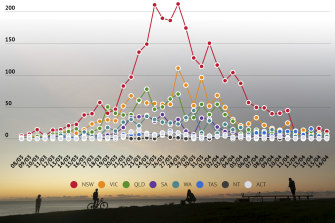
Diagnoses in states and territories over timeCredit:Brook Mitchell
That's the finding of a new paper analysing the pattern of coronavirus infections using a technique dubbed “back projecting”.
Mortality rates, hospitalisations and ICU admissions would rise by the same magnitude, said study author Professor Ian Marschner at the University of Sydney’s Faculty of Medicine and NHMRC Clinical Trials Centre.
The death toll that currently stands at 103 could instead have been over 500.
https://news.google.com/__i/rss/rd/articles/CBMifmh0dHBzOi8vd3d3LnRoZWFnZS5jb20uYXUvbmF0aW9uYWwvdmljdG9yaWEvY29yb25hdmlydXMtdXBkYXRlcy1saXZlLXdvcmxkd2lkZS1pbmZlY3Rpb25zLW5lYXJzLTYtbWlsbGlvbi0yMDIwMDUzMS1wNTR5MHEuaHRtbNIBAA?oc=5
2020-05-30 23:50:00Z
52780822344326
Bagikan Berita Ini














0 Response to "Coronavirus updates LIVE: Worldwide infections nears 6 million - The Age"
Post a Comment